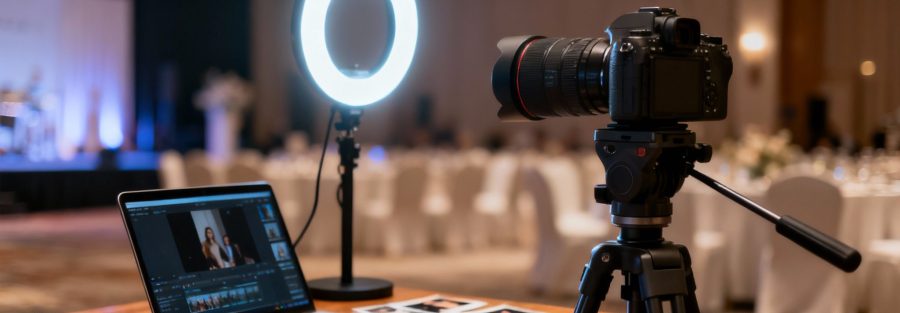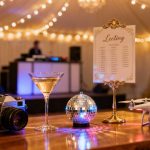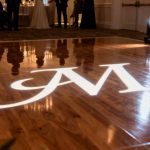When you're picking out the best camera for a photo booth, you're almost always going to land on a DSLR or mirrorless camera. I’ve found that brands like Canon are usually a safe bet, mainly because their software plays nice with most photo booth apps and the image quality is consistently fantastic. A model like the Canon EOS R50, for instance, hits that sweet spot of a high-res sensor, snappy autofocus, and the ability to run on continuous power, which is a lifesaver for long events.
Your Guide to Choosing the Best Photo Booth Camera
So, you're ready to pick the heart of your photo booth. This isn't just about specs on a sheet; it’s about making sure your clients get amazing photos that they'll love and share. Think of this guide as your personal roadmap, helping you navigate from the basics all the way to making a smart, confident purchase.

We’re going to cut through the tech jargon and focus on what actually matters for taking killer event photos. Whether you're just starting out or looking to upgrade your current setup, let's dive into the 'why' behind the best camera choices.
The Growing Demand for Quality Photo Booths
Let's be clear: photo booths aren't just a passing fad. This industry is exploding. The global market was pegged at around USD 624.09 million and is on track to nearly double to USD 1,338.85 million by 2033. That’s a whole lot of weddings, corporate gigs, and parties needing high-quality, fun experiences. Your camera choice is what will set you apart and let you grab a piece of that growing pie.
Part of this boom comes from the fact that you don't need a massive investment to get started. A solid camera, the right software, a good printer, and some fun props are the core of the business. But make no mistake, the camera is the most important piece of that puzzle.
A great camera is the difference between a guest simply taking a picture and creating a cherished memory they'll share for years. It's the engine of your entire photo booth operation.
Understanding Your Camera Options
Before we get into specific models, let's break down the two main types of cameras you’ll be looking at. Each has its own pros and cons for photo booth work.
- DSLR Cameras: For years, these have been the undisputed workhorses of the industry. They're built like tanks, have a massive selection of lenses, and are incredibly reliable. You really can't go wrong with a good DSLR.
- Mirrorless Cameras: These are the newer kids on the block. They're much more compact and lightweight, and their live view autofocus is often a step ahead. Plus, they tend to have better video features if that’s something you might use.
Taking a look at a wide range of cameras is a great first step to see what's out there and what features click with your business plan.
To help you see the differences at a glance, here’s a quick breakdown of how these two camera types stack up for photo booth use.
Quick Look Camera Types for Photo Booths
| Feature | DSLR Cameras | Mirrorless Cameras |
|---|---|---|
| Size & Weight | Bulkier and heavier. Built to last. | Compact and lightweight. Easier to transport and mount. |
| Viewfinder | Optical (you see through the lens). No lag. | Electronic (a mini screen). Shows you the final image exposure in real-time. |
| Autofocus | Fast and reliable, but Live View focus can be slower. | Excellent Live View focus, often with face/eye tracking. Perfect for booths. |
| Battery Life | Generally longer battery life per charge. | Can be shorter due to the electronic viewfinder. AC adapters are a must. |
| Lens Selection | Massive, well-established selection of lenses. | Growing selection, and adapters can be used for DSLR lenses. |
| Video Quality | Good, but often a secondary feature. | Often excels with higher-quality video (4K) and better video autofocus. |
Ultimately, both types can do an incredible job. Your choice will probably come down to whether you prefer the tried-and-true durability of a DSLR or the modern features and smaller size of a mirrorless camera.
The Anatomy of a Great Photo Booth Camera
So, you're on the hunt for the perfect camera for your photo booth. It’s easy to get bogged down by brand names and fancy marketing, but what really matters are the guts of the camera. Think of it as the engine of your whole setup—the right one will hum along all night, but the wrong one will leave you with blurry photos and frustrated guests.
Let's cut through the noise and talk about the technical specs that actually make a difference. These are the non-negotiables that separate a weekend hobby camera from a true professional workhorse.
Sensor Size: Your Secret Weapon for Low-Light Events
First up, and maybe the most important piece of the puzzle, is the camera sensor. The easiest way to think about it is like the camera's retina—it's the part that actually sees and captures the light to make a picture. And just like a bigger bucket catches more rain, a bigger sensor gathers more light. This is your biggest advantage when you're shooting in a dimly lit wedding venue or a moody corporate party.
You'll mainly run into two sensor sizes that fit the bill:
- APS-C: This is the sweet spot for most people. It delivers fantastic image quality and handles low light like a champ, all without the hefty price tag of the top-tier pro cameras. You'll find it in tons of popular DSLRs and mirrorless models.
- Full-Frame: This is the gold standard, no question. A full-frame sensor is the same size as a classic 35mm film frame, and its light-gathering ability is just phenomenal. What that means for you is cleaner, crisper images with way less of that grainy "digital noise," even when you have to crank up the settings.
A bigger sensor simply gives you more breathing room. It lets you capture beautiful, flattering skin tones and vibrant colors without having to blast your guests with a harsh, overpowering flash.
Finding the Megapixel Sweet Spot
Next, let's talk megapixels (MP). There’s a common myth that more is always better, but for a photo booth, that's just not true. You absolutely need enough detail for sharp prints, but going overboard with a 45MP or 60MP camera creates gigantic files. These monster files will bog down your photo booth software, slow down the time between shots, and eat up your hard drive space like crazy.
For photo booth work, the sweet spot is almost always between 20 and 26 megapixels. This gives you more than enough resolution for beautiful 4×6 prints and crystal-clear digital shares, while keeping the files small enough for a snappy, seamless experience.
This is exactly why DSLRs have been the industry standard for so long. Cameras from Canon’s EOS and Nikon’s DSLR lineups nailed this balance, offering fantastic sensors that hit that 20+ megapixel mark, ensuring every photo strip looked pro. You can find more insights on why certain gear became standard.
Manual Controls and Tethering: The Keys to Consistency
Modern cameras are pretty smart, but their "auto" modes can't handle the chaos of a photo booth. That's why manual controls are an absolute must. You need to be able to lock in your settings—aperture, shutter speed, ISO, and focus—and keep them there. This guarantees that every single photo, from the first session to the last, looks exactly the same, no matter what the ambient light is doing or what color outfits people are wearing.
Just as critical is tethering capability. This is just a fancy way of saying the camera can be controlled by your computer through a USB cable. A stable tethered connection is the lifeblood of your operation. It’s what lets your software fire the camera, grab the image instantly, and display it for guests to see.
Lastly, make sure the camera has an external flash hot shoe. It’s that little metal mount on top. This is non-negotiable because it lets you connect a real, professional light source. You cannot rely on the tiny built-in pop-up flash—it’s a recipe for red-eye and awful, shadowy pictures. Getting these features right is the foundation when you learn how to create a photo booth that delivers amazing results every time.
DSLR vs Mirrorless: Which Camera Is Right for You?
The photography world loves a good debate, but the DSLR versus mirrorless showdown hits differently when we're talking about a photo booth. This isn’t just about getting the best picture; it’s about rock-solid reliability, easy operation, and creating a totally smooth experience for your guests. Let's dig into these two camera types and figure out which one is the perfect fit for your photo booth business.
Think of a DSLR (Digital Single-Lens Reflex) camera as the trusty, battle-tested workhorse. For years, these were the kings of the photo booth industry, and for good reason. They are built like tanks, which is a massive plus for gear that gets hauled around and set up over and over again.
Their biggest selling points are their proven reliability and the massive ecosystem built around them. You can find a huge selection of affordable lenses, and their battery life is often fantastic—a lifesaver during a long four or five-hour event. The main downside? They're bulky and heavy, which can make them a bit clunky for those sleek, modern photo booth builds.
This infographic lays out the must-have features you need, no matter which type of camera you end up choosing.
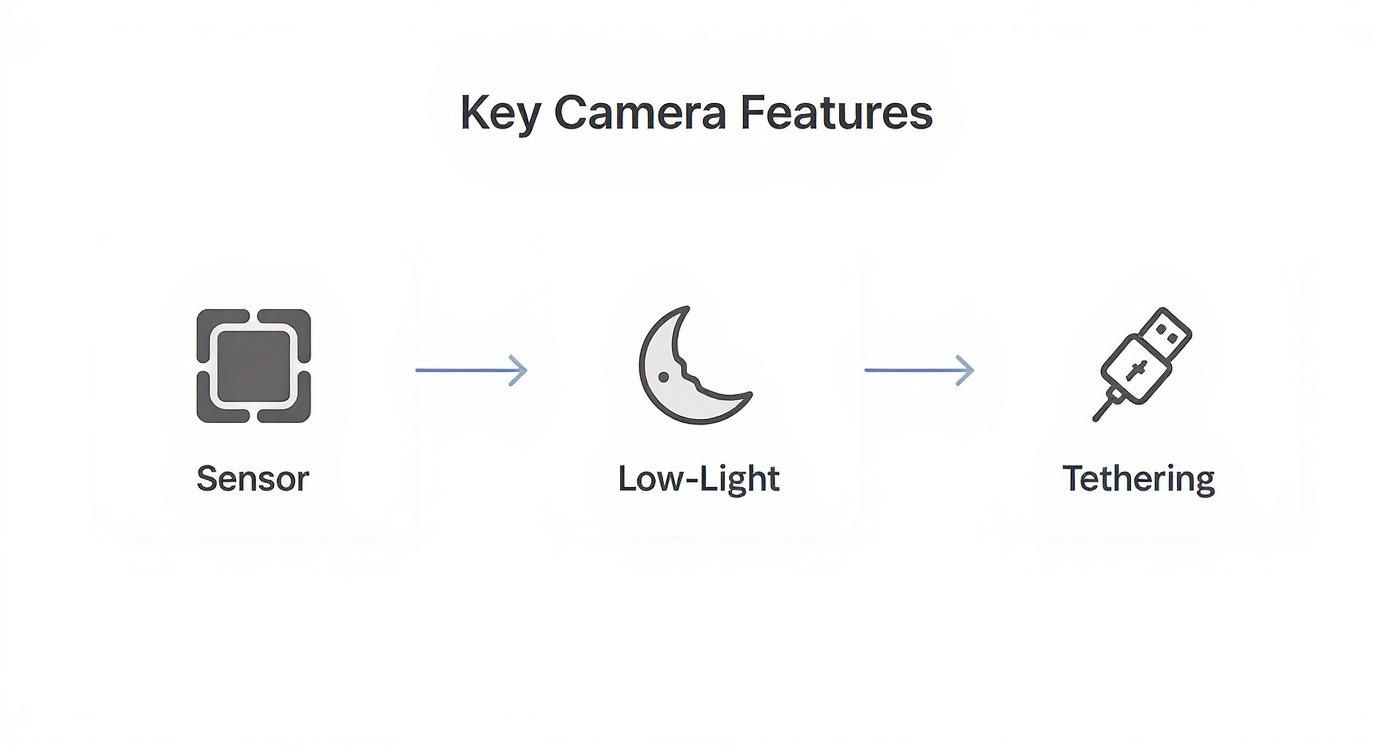
As you can see, things like sensor performance, how well it sees in the dark, and solid tethering are the real cornerstones of a pro setup, regardless of the camera body.
The Modern Challenger: Mirrorless Cameras
On the other side of the ring, we have mirrorless cameras. These are the slick, modern contenders, and they’ve got some serious tricks up their sleeves. The first thing you'll notice is how compact and lightweight they are. This makes packing up and heading to an event a breeze, and it opens up a world of creative, smaller photo booth designs.
But where mirrorless cameras really pull ahead is with their tech. They generally have way better autofocus systems, especially in "live view"—which, by the way, is the only mode your photo booth will ever use. Features like real-time eye and face tracking are absolute game-changers, making sure every shot is tack-sharp, even when you have a chaotic group of people goofing around. It’s a huge leap forward from the sometimes sluggish live view focus on older DSLRs.
Choosing between a DSLR and a mirrorless camera often comes down to a simple trade-off: Do you prioritize the proven, rugged reliability of a DSLR, or the advanced autofocus and compact size of a mirrorless system?
Now, the classic knock against mirrorless models is battery life, which is usually shorter because their screens and sensors are always on. For a stationary photo booth, though, this is a total non-issue. You just plug it in with an AC power adapter, and you're good to go all night long. As you weigh your options, our guide on the best camera for event photography might also be helpful, since it tackles similar challenges in unpredictable settings.
Making the Final Call for Your Business
So, what's the verdict? Honestly, there’s no single right answer. It all boils down to your specific needs and business goals.
- Go with a DSLR if: You put a premium on rugged durability, want access to a massive and cheap market of used lenses, and like having that long battery life for other gigs outside the booth.
- Go with a mirrorless camera if: You’re aiming for a lightweight and compact setup, you want the smartest and most reliable autofocus you can get, and you might want to tap into modern perks like better video quality.
At the end of the day, both camera systems can deliver absolutely beautiful images. Newer mirrorless options like the Canon EOS R50 are quickly becoming the favorite for new photo booth operators, packing incredible performance into a great price. But a tried-and-true DSLR like a Canon Rebel is still a fantastic, budget-friendly workhorse that will get you professional results. Just know that this choice really shapes your workflow, so think it through
Top Photo Booth Camera Picks for Every Budget
Alright, let's get to the good stuff—chopping through the options to find the perfect camera for your business. Picking the right camera for your photo booth isn't about dropping a ton of cash. It's all about finding that sweet spot between features, rock-solid reliability, and a price that makes sense for you.
We've broken down our top recommendations into three simple categories. So, whether you're just starting out or you're ready to build a high-end setup, we've got you covered.
Entry-Level Champions
Just because you're on a budget doesn't mean you have to skimp on quality. The cameras in this tier are affordable, tough, and more than capable of cranking out awesome images that will have your clients raving. Think of these as the dependable workhorses of the industry.
Our top pick here is the Canon EOS R100. This little mirrorless camera is a powerhouse for the price. You're getting a fantastic 24.1 MP APS-C sensor—perfect for crisp prints and social media shares—plus Canon's super-reliable face and eye-tracking autofocus.
- Incredible Value: It gives you modern mirrorless tech at a price that's tough to argue with, making it a perfect starting point.
- Compact and Light: Its small frame makes it a breeze to fit into any photo booth shell or enclosure. No fuss, no hassle.
- Proven Performance: It uses Canon's legendary color science, which means skin tones look fantastic right out of the camera.
Sure, you could save a few bucks on a used Canon Rebel DSLR, but the R100's newer tech and smarter autofocus will save you from those dreaded blurry shots. It's a smart investment that's built for today.
Mid-Range Powerhouses
For growing businesses ready to take things up a notch, the mid-range is where it's at. These cameras offer the perfect blend of advanced features and reasonable cost, bringing faster performance, tougher builds, and better image processing to the table.
The hands-down winner here is the Canon EOS R50. For just a bit more than the R100, you get a serious upgrade across the board. The R50 boasts a more advanced autofocus system with 651 zones and slick AI subject detection, a faster processor for cleaner photos, and a fully articulating flip-out touchscreen.
The R50 hits the ultimate sweet spot. It delivers pro-level features like advanced AI autofocus and USB-C power delivery in a body that’s affordable enough for any growing photo booth business.
This camera is an absolute favorite among new and seasoned pros for a reason. That flip-out screen is a lifesaver during setup, and being able to power it via USB-C gives you so much more flexibility on-site. It’s a camera that will easily grow with your business for years to come.
Pro-Level Investments
When you're catering to clients who demand the absolute best and you're building a premium brand, it's time to invest in a full-frame camera. A full-frame sensor is physically larger, allowing it to capture more light. The result? Images with less noise, richer colors, and buttery-smooth tones. The difference is real, especially at high-end events.
Our go-to recommendation for the top tier is the Canon EOS R8. This is Canon's entry-level full-frame mirrorless camera, and it delivers jaw-dropping image quality that will instantly set your service apart. Its 24.2 MP full-frame sensor is a beast in low light, which is a common battle at weddings and corporate gigs.
- Superior Image Quality: The larger sensor provides detail and low-light performance that smaller cameras just can't touch.
- Wider Field of View: A full-frame camera gives you a wider perspective with the same lens, which is a game-changer for squeezing big groups into a tight space.
- Impresses High-End Clients: For premium events like galas or red-carpet parties, the quality from a full-frame camera justifies a higher price tag.
The R8 is definitely an investment, but it's one that pays off big time in client satisfaction and the overall polish of your portfolio. When you're designing a high-end experience, every detail matters, and our guide to creating a memorable photo shoot booth can help you tie all those premium elements together perfectly. Think of this camera as the powerful engine that drives that top-tier service.
Recommended Photo Booth Cameras by Budget
To make it even easier to see how these cameras stack up, we've put together a quick comparison table. This breaks down our top picks and shows you exactly what you're getting at each price point.
| Tier | Model Example | Key Feature 1 | Key Feature 2 | Best For |
|---|---|---|---|---|
| Entry-Level | Canon EOS R100 | 24.1 MP APS-C Sensor | Excellent Autofocus | Startups & budget-conscious operators |
| Mid-Range | Canon EOS R50 | Advanced AI Autofocus | USB-C Power/Flip Screen | Growing businesses needing versatility |
| Pro-Level | Canon EOS R8 | 24.2 MP Full-Frame Sensor | Unmatched Low-Light | Premium events & high-end brands |
Ultimately, whether you go for the budget-friendly R100, the all-around R50, or the premium R8, you're getting a camera that will serve you well. It's all about matching the hardware to your business goals and the type of events you want to book.
Essential Gear Beyond the Camera Body
Okay, so you've picked out the perfect camera for your photo booth. That's a huge step, but it’s only one piece of the puzzle. To really build a setup that wows clients and runs without a hitch, you need to surround that camera with the right supporting cast.
Think of it like a band. Your camera is the lead singer, but it can’t put on a killer show without the drummer, bassist, and guitarist backing it up.
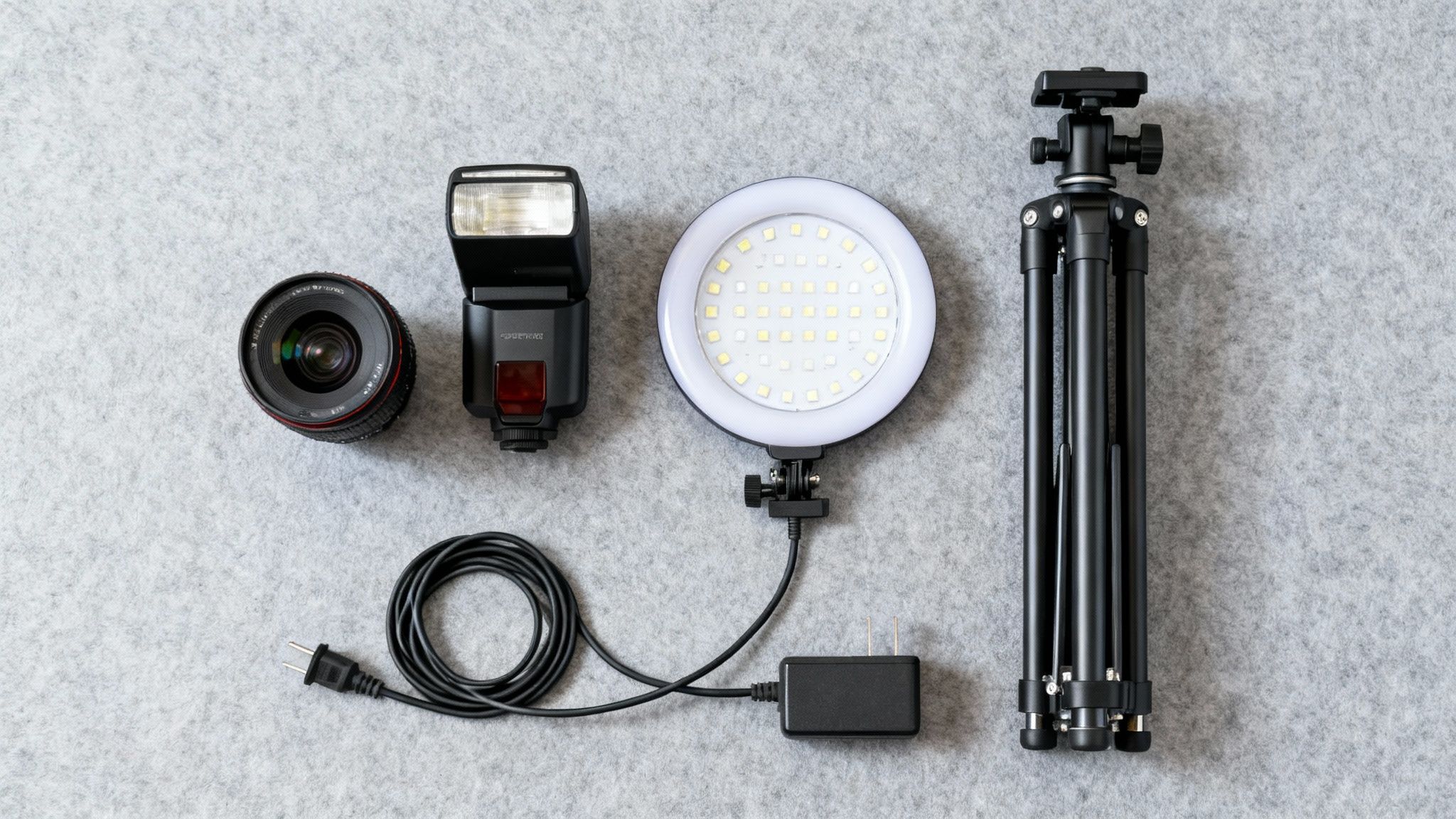
This other gear is what takes your service from a simple snapshot station to a polished, high-end experience. Let's walk through the must-have accessories that will keep your photo booth humming all night long.
The Right Lens for the Job
Your camera’s lens is its eye, and for a photo booth, you need an eye that can see the whole party. The main goal here is to capture fun, dynamic groups, not just tight headshots. This is where focal length becomes super important. A wider focal length lets you cram more people into the shot without having to park the camera way across the room.
For most setups running an APS-C sensor camera (like the popular Canon R50 or R100), here’s what you should be looking at:
- 18-55mm Kit Lens: This is the jack-of-all-trades lens that often comes bundled with a camera. It’s a fantastic starting point. The 18mm end is wide enough for group shots, and having the zoom gives you some nice flexibility.
- 24mm Prime Lens: A "prime" lens has a fixed focal length—it doesn't zoom—but it usually produces sharper images and works much better in low light. A 24mm on an APS-C camera is pretty much the sweet spot for perfect group photos.
For a photo booth, wider is almost always better. It encourages guests to pile into the frame, creating those classic, high-energy group shots that everyone loves to share.
Lighting Your Scene Perfectly
Great lighting is the secret sauce for flattering, professional-looking photos. You absolutely cannot rely on the dim, moody lighting of an event venue. You’ve got to bring your own consistent, high-quality light source. Your two main options create pretty different looks.
Getting this right is one of the most crucial parts of your whole setup. For a deeper dive into creating the perfect glow, our guide to mastering your photo booth lighting setup has a ton more detailed tips and tricks.
- Continuous LED Ring Lights: These are incredibly popular for a good reason. They throw a constant, soft, and flattering light that wraps around faces, zaps harsh shadows, and creates that cool "catchlight" in the eyes. Plus, they keep the live view on your screen bright and clear for guests to see themselves.
- External Strobes (Flashes): A strobe delivers a powerful pop of light that freezes motion dead in its tracks. The result? Incredibly sharp, crisp images. When you pair a strobe with a softbox or an umbrella to soften the light, you can get a really polished, studio-quality look.
The Unsung Heroes of Your Setup
Finally, let's talk about the gear that works behind the scenes to prevent total disaster. This stuff isn't glamorous, but it’s absolutely essential if you want to run a professional operation.
First up is a sturdy tripod or mounting system. Your camera needs to be locked down tight, stable, and at just the right height. A wobbly, cheap tripod is a recipe for blurry photos and can even be a safety hazard if someone bumps into it.
Next is a reliable AC power adapter, which you'll often hear called a "dummy battery." Your camera's regular battery will die mid-event. It’s not a question of if, but when. An AC adapter plugs straight into the wall, giving you continuous power so your camera never unexpectedly shuts down.
Last but not least are your tethering cables. A high-quality, durable USB cable is the lifeline between your camera and your software. A cheap or faulty cable will cause constant disconnects and bring your entire operation to a screeching halt. Spending a little extra on these support items is really an investment in your own peace of mind.
Dialing in the Perfect Camera Settings
Having a great camera is one thing, but the real secret sauce is in the settings. Think of your camera's manual mode as your personal command center. While "auto" mode is just guessing, manual mode lets you lock in the perfect look for consistent, professional-grade photos all night long.
Consistency is king in a photo booth. You need the first shot of the event to look just as good as the last one, no matter what's happening with the venue's lighting. So, let’s walk through a solid set of starting-point settings that will get you sharp, flattering, and amazing photos every time.
Aperture: The Key to Sharp Group Shots
First things first, let's talk about aperture. This setting controls how much of your picture is in focus, from front to back. In a photo booth, you're constantly cramming groups of people into the frame, and they're never all standing in a perfect line. If you use a wide-open aperture (like f/1.8), you get that "blurry background" effect, which is great for portraits but terrible for groups. You'll end up with one person in focus and everyone else looking soft.
To get everyone sharp, you need a narrower aperture. This creates a deep "depth of field," which is just a fancy way of saying more of the scene is in focus.
- Your go-to starting point: Set your aperture to f/8.
- For really big groups: If you've got a huge crowd and notice the folks in the back are a little blurry, push it to f/11.
Honestly, this one tweak is probably the biggest secret to getting those tack-sharp group photos that make clients happy. It’s a foundational trick, and you can find more tips for event photography that build on this idea.
Shutter Speed and ISO for Crisp, Clean Images
Next up, we need to freeze the action. People are going to be laughing, moving around, maybe even throwing props. If your shutter speed is too slow, all that awesome energy just turns into a blurry mess.
Your goal here is to find the sweet spot between freezing motion and keeping the image quality high.
- Shutter Speed: Lock this in at 1/125s. This is fast enough to stop the typical photo booth shenanigans without needing a ridiculous amount of light.
- ISO: Keep your ISO as low as you can possibly go. Start at ISO 100 or ISO 200. A low ISO gives you the cleanest, most professional-looking photos without any of that ugly grain or "digital noise."
The only time you should ever bump up your ISO is if your flash just can't put out enough light. A clean, low-ISO image always looks more premium.
Manual Focus and White Balance: Take Back Control
Alright, last two things. We're going to stop the camera from guessing about focus and color. Autofocus is a modern marvel, but in a fixed setup like a photo booth, it can sometimes get confused and focus on the backdrop or a shiny prop instead of people's faces.
Pro Tip: Flip your camera and lens over to Manual Focus (MF). Have someone stand where your guests will be (or just put a light stand there) and dial in the focus perfectly. Once it’s sharp, don't touch it again for the rest of the night. Every single shot will be nailed.
Event lighting can also be a total nightmare for color. You've got the venue's weird lights mixing with the DJ's uplighting, and it can throw your camera's auto white balance for a loop. One minute skin tones look orange, the next they're blue. By setting a custom white balance with a simple grey card under your photo booth lights, you guarantee that every photo has perfect, true-to-life colors.
Common Photo Booth Camera Questions
Jumping into the world of photo booth cameras can feel like a deep dive, especially when you're trying to nail down the perfect setup. Let's walk through some of the questions I hear all the time to get you on the right track.
Can I Use an Older DSLR Camera?
You bet! An older, second-hand DSLR, like a trusty Canon Rebel, can be an absolute workhorse for a photo booth. These cameras were built to last and their image quality is still fantastic for standard prints.
The biggest thing to watch for is compatibility. Just make sure it has manual controls, can take an AC power adapter (you don't want batteries dying mid-event!), and—most importantly—is still supported by your photo booth software. Always double-check that software compatibility list before you pull the trigger on a used camera.
Should I Use a Prime or Zoom Lens?
This is a classic debate, but for photo booths, the answer is pretty straightforward. While a zoom lens seems more versatile, a prime lens is almost always the better choice. A prime lens has a fixed focal length, like a 24mm, meaning it doesn't zoom.
Think of it this way: a prime lens is an expert at one thing. It's usually sharper, lets in more light (which is great for dim venues), and forces you to be consistent with your booth's distance from the backdrop. That consistency is your secret weapon for getting predictable, great-looking shots every single time.
Do I Really Need an External Flash?
Yes. A thousand times, yes. That little pop-up flash on top of the camera? It’s not your friend. It creates harsh, flat light, weird shadows, and the dreaded red-eye effect. It’s just not a professional look.
An external light source, like an LED ring light or a studio strobe with a softbox, is what separates amateur shots from pro-quality photos that get people talking. This is more important than ever. In fact, demand for photo booths at corporate events has jumped by 150% recently, and those clients expect top-tier quality. If you want to learn more, you can discover more insights about this growing market trend.
At 1021 Events, we know that the right gear is just one piece of the puzzle. From polished photo booths to full-scale event production, we bring the expertise to make your entire celebration a hit. Explore our event services today.

